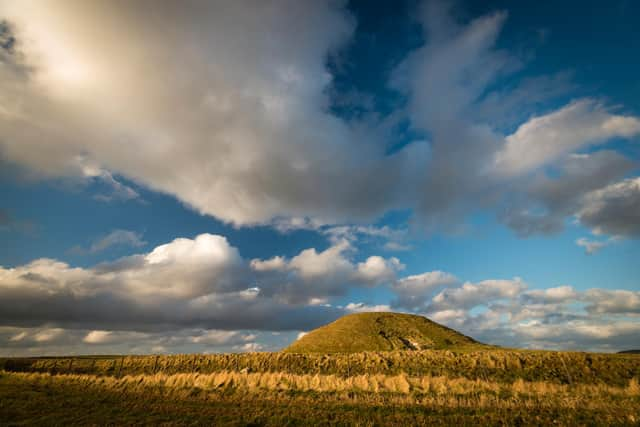Mysteries of Maeshowe on Winter Solstice illuminated in celebration of shortest day
Maeshowe Chambered Cairn is flooded with light on the dark midwinter afternoons, with the path of the setting sun at this time of year aligned perfectly with the narrow passageway into the 5,000-year-old tomb.
The purpose of this ancient light show remains largely unexplained, although some believe the alignment could act as a type of calendar to signal the coming of longer days. Others believe it represented the renewal of life of those laid in the tomb, or the returning of the souls to the dead.
Advertisement
Hide AdAdvertisement
Hide AdThis year, a new film exploring the fascinating story of Maeshowe is being live streamed from Orkney at 3pm on the Winter Solstice, just as the sun starts to set today.


Sian Evans, regional visitor operations manager for Historic Environment Scotland (HES) in Orkney said: “The Winter Solstice has a special place in Orkney and, of course, traditionally marks the beginning of winter and the coming of darkness.
"Maeshowe has always played a special part in that tradition through the spectacular light show that is visible on clear days as the sun sets overhead, and this wonderful new film offers viewers a unique insight into that connection, as well as highlighting what is one of the most fascinating heritage sites in the world.
“We are really looking forward to sharing this film and to giving people the chance to see and enjoy the magic of Maeshowe and the Winter Solstice from the comfort of their own homes, hopefully inspiring them to enjoy our wider Orkney heritage and rich history.”
Those appearing in the film include Professor Colin Richards, archaeologist and lecturer at University of the Highlands and Islands.
He said Maeshowe was constructed to a different scale than other passage graves on Orkney, and was built to impress.
Prof Richards said: “It’s built differently. Its magnitude is enormous. This is about wonder, awe, amazement.
"This really is a spectacular monument. This is meant to impress. It’s all about spectacle, it’s all about people.”
Advertisement
Hide AdAdvertisement
Hide AdThe midwinter sun shines into the passageway for around 20 days before Winter Solstice and for roughly 20 day afterwards, with the light cast on the far wall creating a spectacular effect in the darkness of the tomb.
Prof Richards suggested the light coming into the tomb may have represented renewal and regeneration for the Neolithic farming community. It could also perhaps symbolise the awakening of their ancestors as the light shines upon them.
In previous years, a live stream has been held at Maeshowe, although the tomb remains closed to the public given the pandemic.
This year, the newly-created film also features the premiere of a new poem by Alison Miller, the Orkney Scriever, which has been inspired by the Solstice.
Meanwhile, local storyteller Tom Muir shares a short story centred on Orcadian folklore and the shortest day.
The work of Orcadian artist Louise Barrington, whose work is inspired by Maeshowe, is on show at the visitor centre until February.
A message from the Editor:Thank you for reading this article. We're more reliant on your support than ever as the shift in consumer habits brought about by Coronavirus impacts our advertisers.
If you haven't already, please consider supporting our trusted, fact-checked journalism by taking out a digital subscription.
Comments
Want to join the conversation? Please or to comment on this article.
